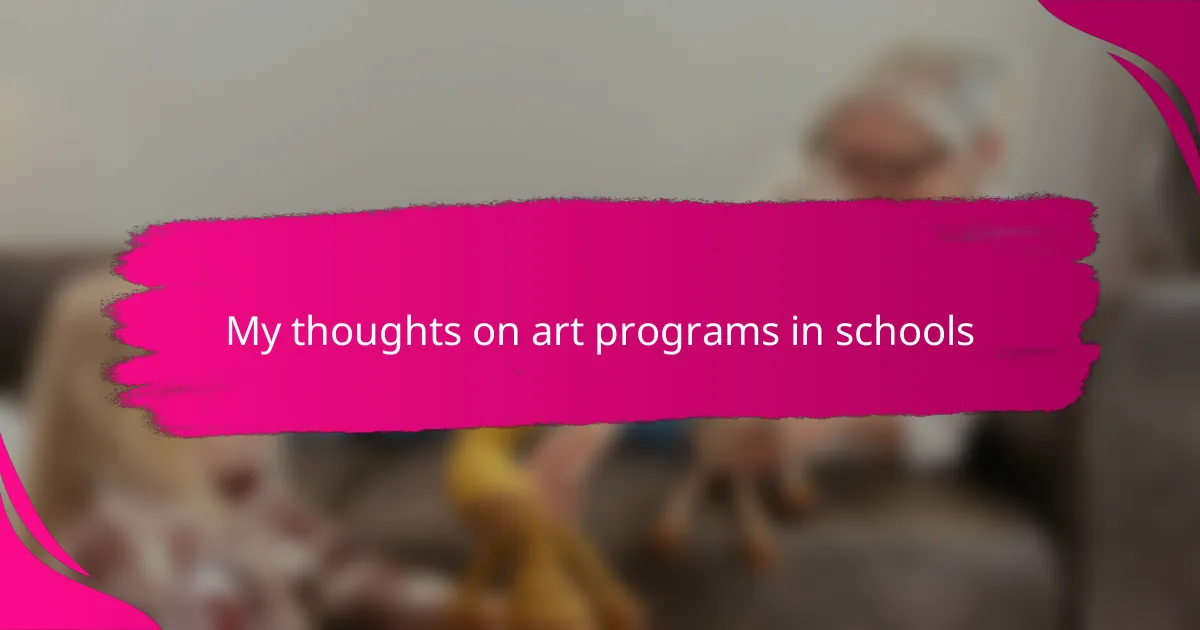Key takeaways
- Art programs in schools nurture creativity, emotional expression, and critical thinking skills in children.
- Engaging with art can help children process their emotions, improve focus, and enhance cognitive abilities.
- Parents can support art learning at home by creating dedicated spaces and encouraging exploration and choice in art activities.
- Advocating for school art programs is essential to ensure access to quality materials and reinforce the value of creative education.
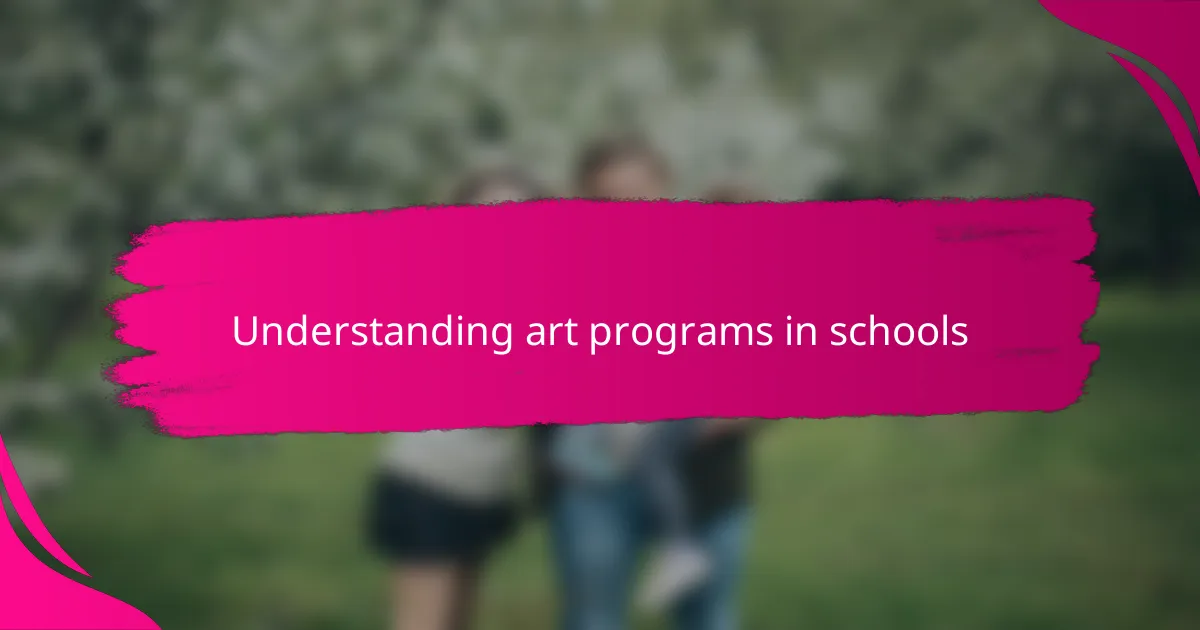
Understanding art programs in schools
Art programs in schools often get overlooked, but from my experience, they are essential in nurturing creativity and emotional expression. I remember how my own child’s confidence blossomed when she painted her first canvas; it wasn’t just about art—it was about finding her voice. Have you ever wondered how often children get chances to explore their imaginations in the rigid structure of traditional classrooms?
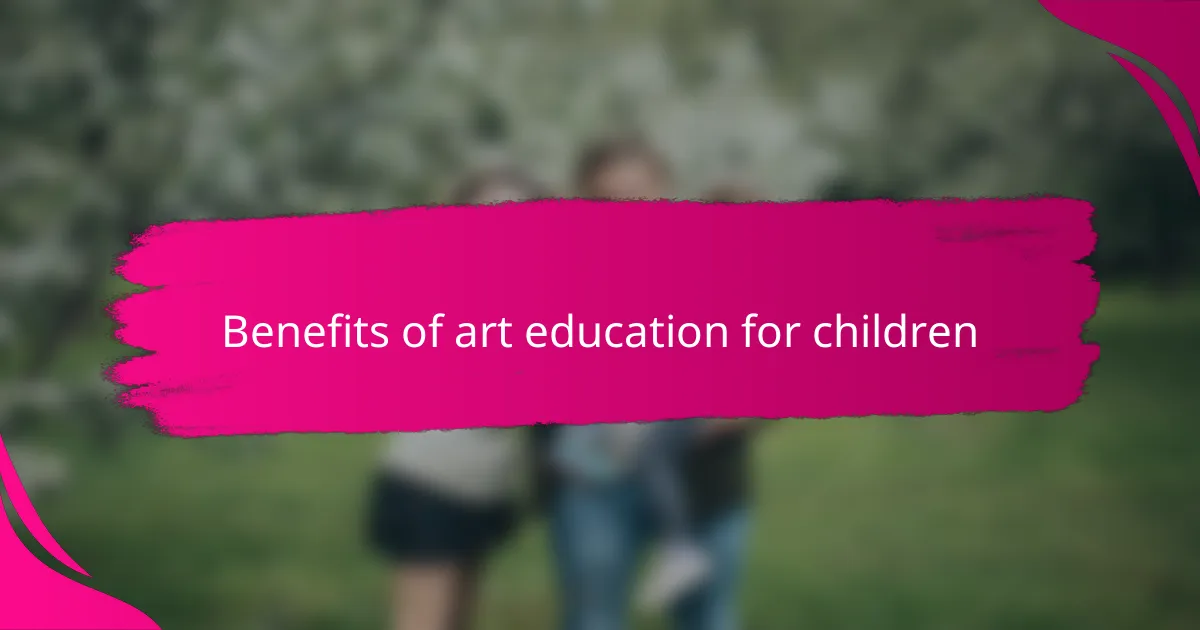
Benefits of art education for children
Art education does more than just teach kids how to draw or paint; it helps them develop critical thinking and problem-solving skills. I’ve noticed that when my child engages with art, she learns to approach challenges with a curious and open mind, which spills over into her schoolwork and daily life. Isn’t it fascinating how a simple art lesson can boost a child’s ability to think outside the box?
Another benefit I’ve seen firsthand is how art programs provide a safe space for emotional expression. Children often struggle to put feelings into words, but through colors and shapes, they find a language of their own. Watching my child channel her emotions into her artwork made me realize how powerful and healing creative outlets can be for young minds.
Moreover, art education fosters social skills and collaboration. When kids work on group projects or share their creations, they learn to communicate and appreciate different perspectives. Have you ever observed how a classroom art activity can bring shy children out of their shells? It’s moments like those that highlight the true value of art in building confidence and connection.
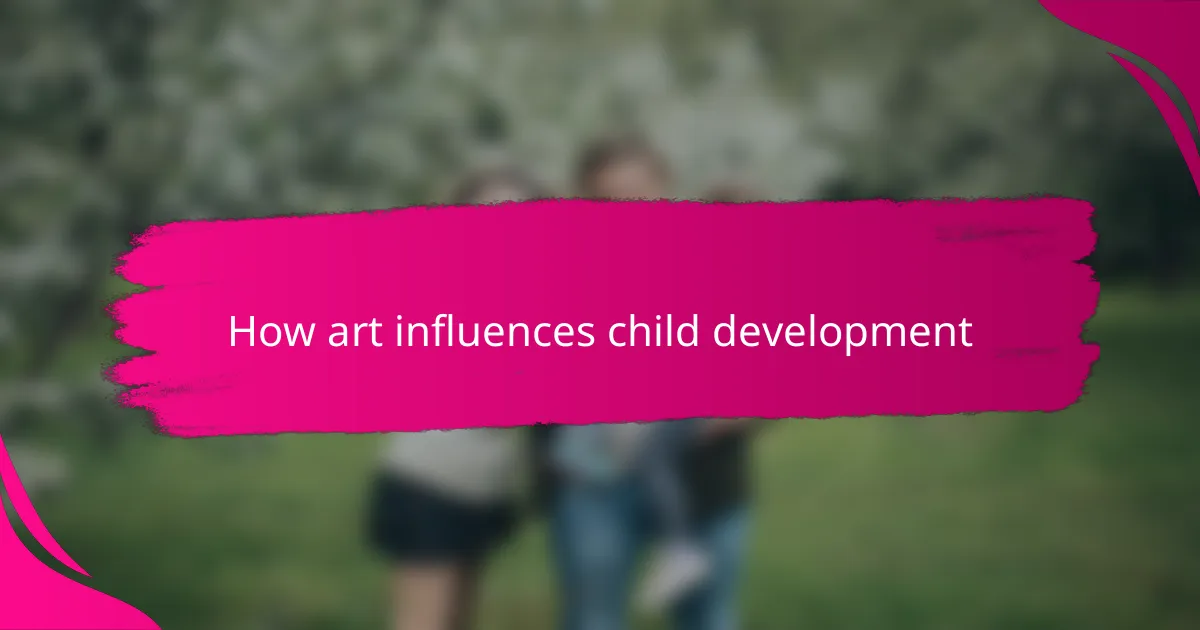
How art influences child development
Art has a remarkable way of shaping how children perceive the world around them. From my own experience, I’ve seen art activities spark curiosity and improve fine motor skills, which are crucial during early development. Have you ever noticed how a simple brushstroke or clay model can transform a child’s focus and patience?
When my child first started experimenting with different textures and colors, I observed her cognitive abilities deepen—she began noticing patterns and making connections that I hadn’t expected. It’s as if art becomes a lens through which children learn to organize their thoughts and understand complex ideas. Doesn’t it amaze you how something so creative can also be so intellectually stimulating?
Emotionally, art offers children a safe haven to process what they might find overwhelming in daily life. I remember a day when my child was struggling to explain her worries, but through her painting, she communicated feelings far beyond words. Isn’t it incredible how art can provide that kind of emotional clarity and relief for young minds?
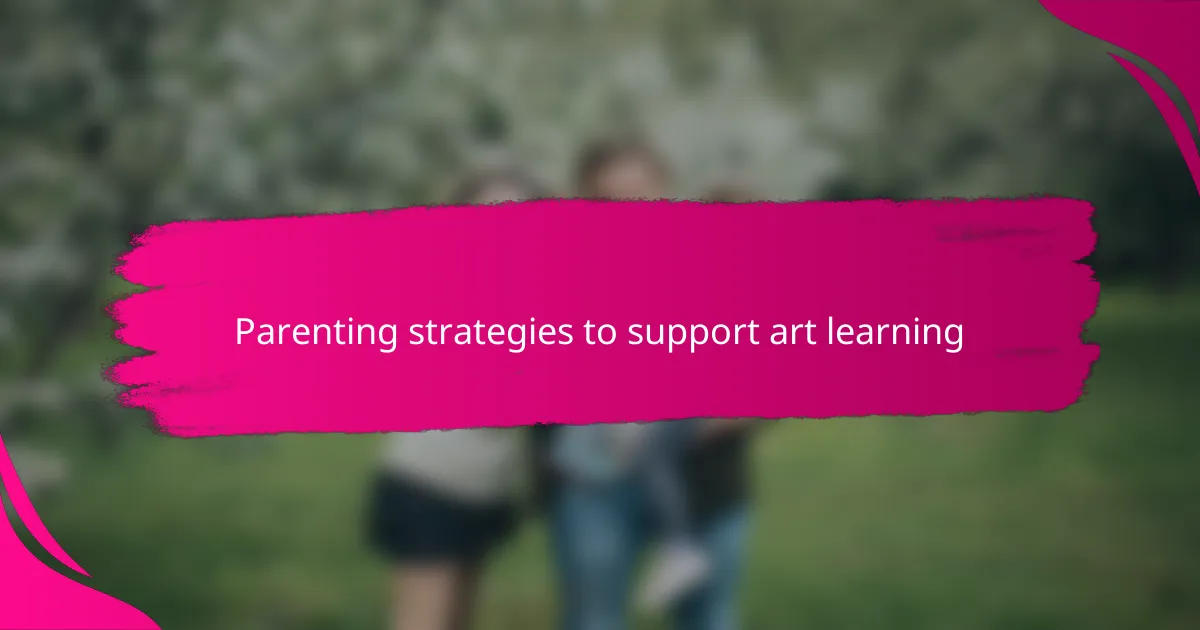
Parenting strategies to support art learning
Supporting your child’s art learning at home can be a game-changer. I found that setting up a dedicated art space, even if it’s just a small corner with supplies, encourages my child to create freely without feeling rushed. Have you ever noticed how having a special spot makes art feel like an inviting adventure rather than a chore?
Engaging with your child during their art projects also makes a big difference. When I ask open-ended questions like, “What story does your painting tell?” or “How did you choose these colors?”, it helps my child think deeper about their work and feel truly heard. Doesn’t sharing these moments strengthen not just their creativity but your bond as well?
Lastly, encouraging art beyond the classroom helps sustain their passion. I make it a habit to explore museums, community workshops, or simply new art materials together. I’ve seen firsthand how these experiences widen my child’s perspective and fuel her enthusiasm. What new creative experiences could you introduce to spark your child’s imagination today?
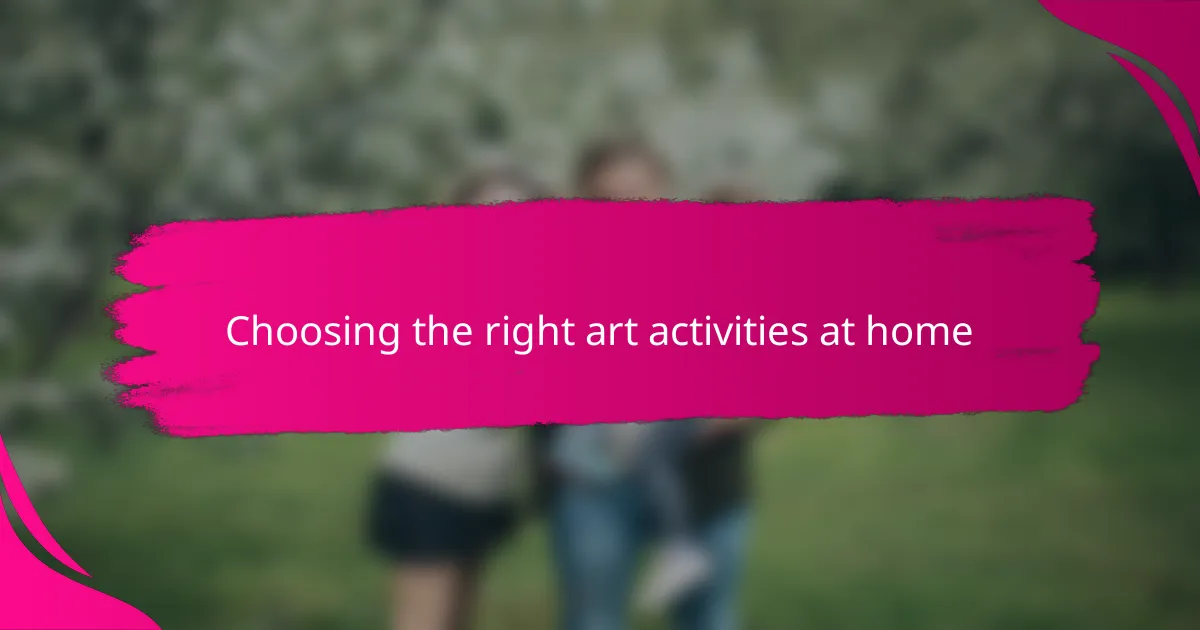
Choosing the right art activities at home
Choosing the right art activities at home starts with tuning in to what truly excites your child. I’ve found that when my daughter chooses her own materials—whether it’s finger paints, clay, or even recycled items—her enthusiasm and creativity soar. Have you observed how much more engaged kids become when they feel in control of their artistic choices?
It’s important to balance structured activities with open-ended exploration. For instance, I sometimes set up simple prompts like “create something that makes you happy,” but I also let my child wander freely in her art, discovering shapes and colors on her own. This mix keeps art time both meaningful and fun, don’t you think?
Also, consider your child’s developmental stage and interests when picking activities. When my son was younger, he loved tactile experiences like finger painting, which helped with his motor skills. Now that he’s older, he enjoys more detailed projects like collage or sketching. Matching activities to their growth really makes a difference in keeping art both challenging and enjoyable. Have you noticed similar shifts as your children grow?
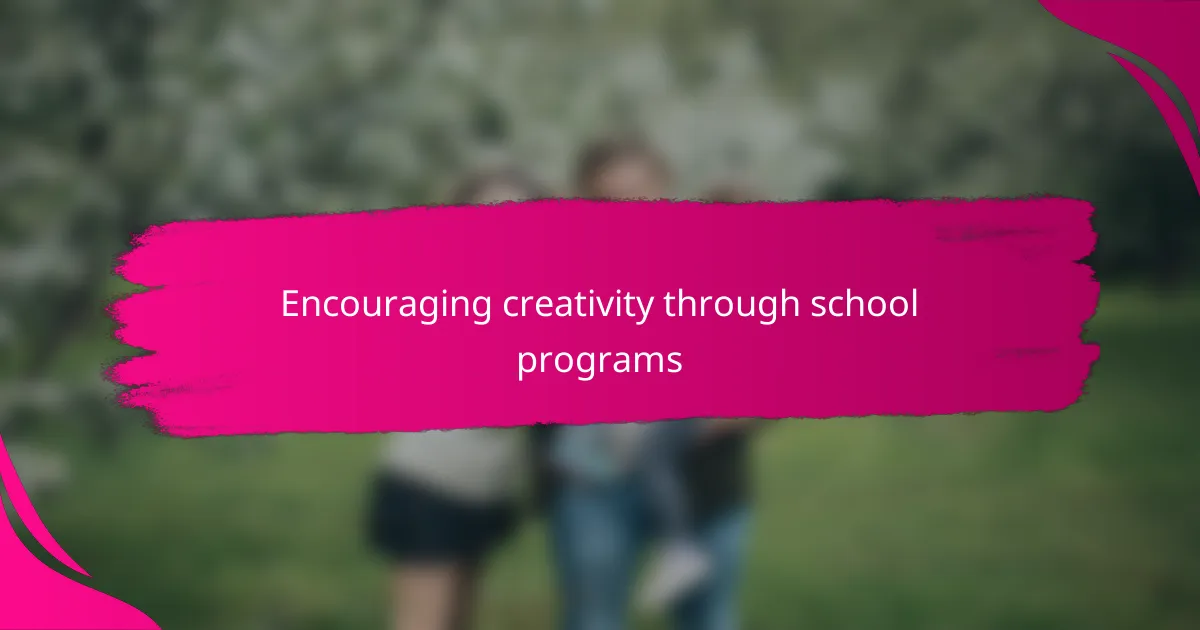
Encouraging creativity through school programs
One of the most powerful ways school art programs encourage creativity is by giving children permission to dream without limits. I’ve seen how a simple assignment can ignite a flood of original ideas when kids feel safe to experiment and make mistakes. Isn’t it refreshing to witness young minds untethered from the usual “right or wrong” mindset?
From my perspective, these programs also introduce students to diverse art forms they might never encounter at home. When my child brought home a project inspired by abstract art, it sparked curious conversations about different styles and cultures. Doesn’t that exposure open doors to new ways of thinking that benefit creativity far beyond the classroom?
Finally, the collaborative nature of many school art activities teaches children how to blend their ideas with others’, fostering a unique kind of creative teamwork. I recall how group mural projects at my child’s school brought out unexpected leadership and empathy, nurturing skills that extend well into life. Have you noticed how sharing a creative process can strengthen both imagination and social bonds?
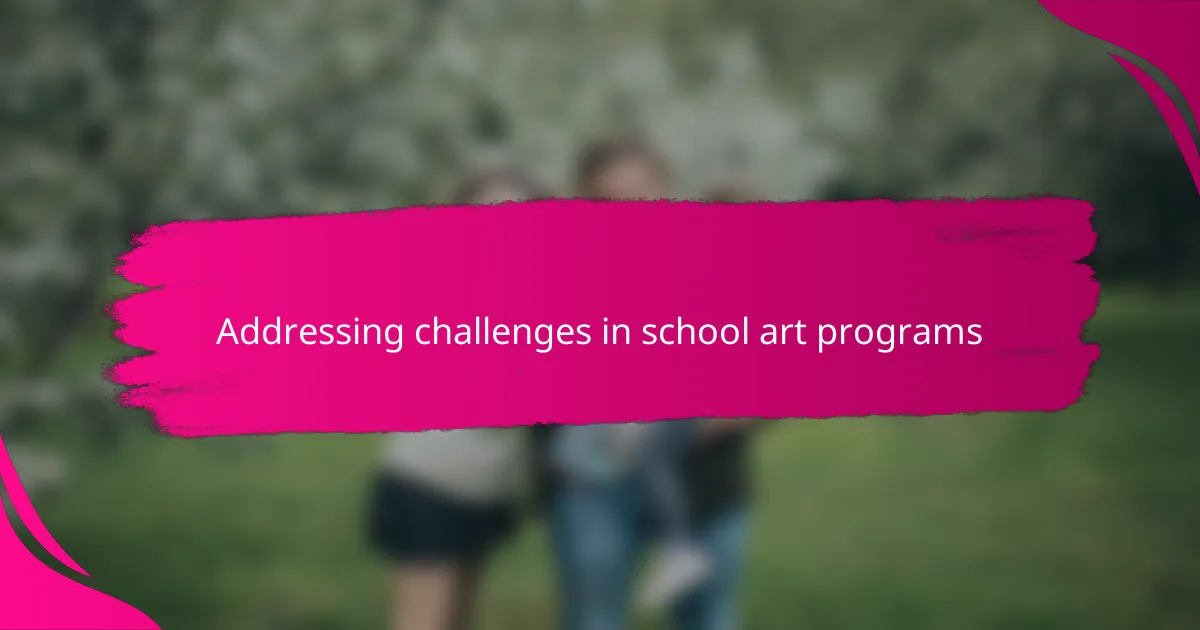
Addressing challenges in school art programs
One of the biggest hurdles I’ve seen in school art programs is limited funding, which often means fewer supplies and less time dedicated to art. It’s frustrating because I believe every child deserves access to quality materials that inspire creativity, just like my daughter felt when her school finally got new paints—her excitement was palpable. How can we expect children to flourish artistically if their tools are always second best?
Another challenge lies in the pressure to prioritize core subjects like math and reading over creative ones. I’ve noticed teachers juggling tight schedules, leaving art as an afterthought rather than a valued part of the curriculum. Doesn’t it seem counterproductive when schools overlook art’s role in developing critical thinking and emotional intelligence?
Addressing these issues requires a community effort. From my experience, advocating for art programs and volunteering can make a real difference, whether that’s rallying parents to support funding or helping teachers with art activities. Have you ever tried joining forces with your child’s school to ensure art remains a vital part of education? It’s a worthwhile endeavor that benefits everyone involved.
